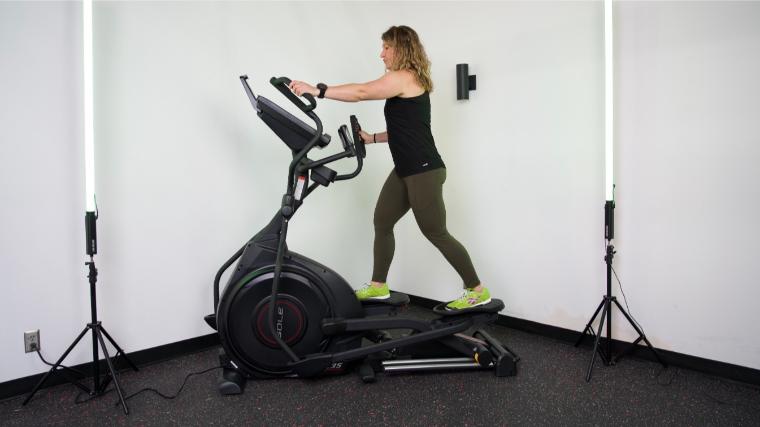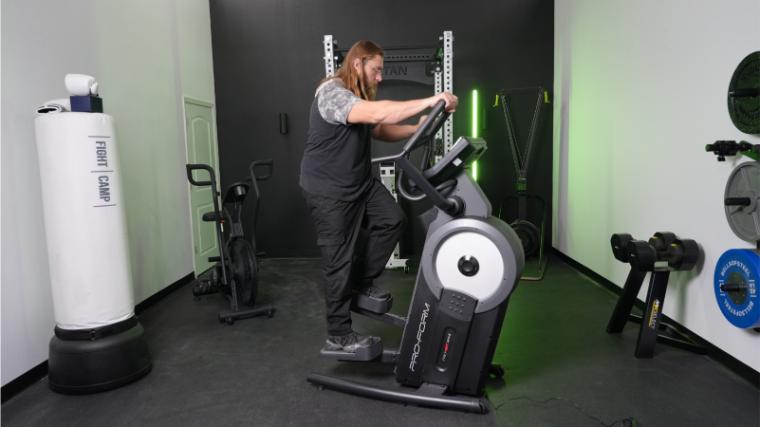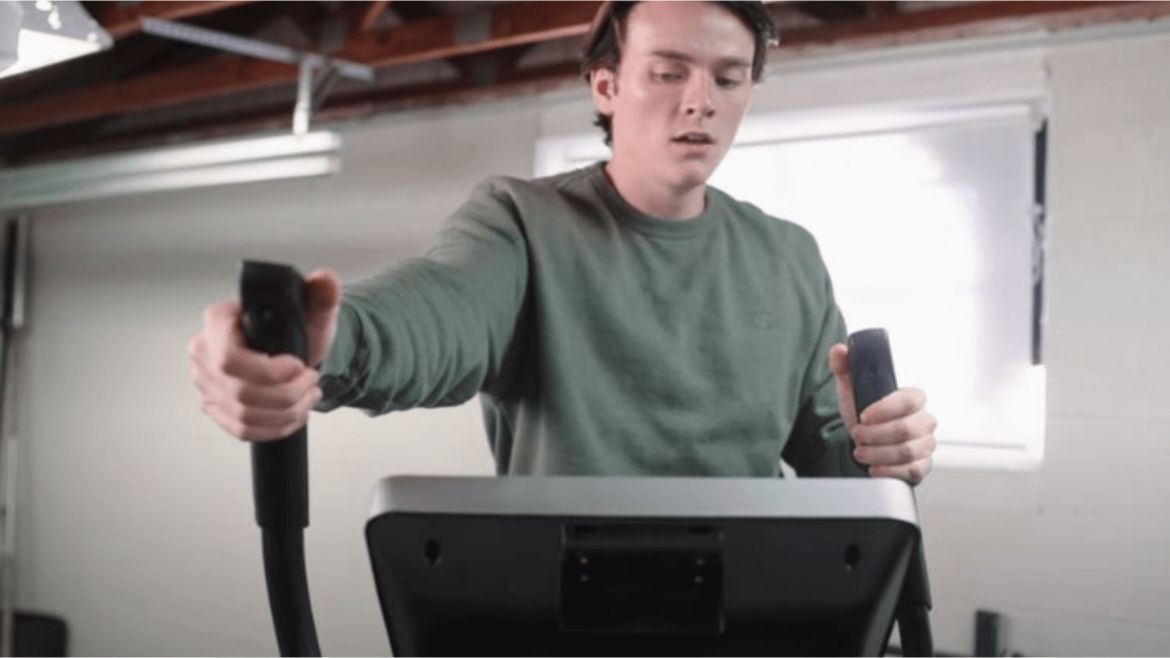Since the Precor 544 EFX — or Elliptical Fitness Crosstrainer — first made significant inroads into the fitness market in 1996, the elliptical has become one of the most recognizable pieces of exercise equipment. Beyond its original premium gym model, it has taken on several different forms. This means everything from the foot pedals and handlebars to the stride length and resistance levels may vary from one elliptical to the next.
This can make it extremely challenging to pinpoint exactly which elliptical machine is best suited to help you achieve your fitness goals at home. Well, whether you prioritize adjustable stride length, Bluetooth connectivity, or full-body workout potential, this elliptical buying guide will help you identify the best ellipticals for your own home gym.
Types of Ellipticals
Elliptical machines have evolved remarkably since their first iterations to include several alternative models that are sold alongside the two most common varieties — front-drive and rear-drive ellipticals.
No matter which elliptical model you select, you’re going to get a workout that challenges several muscle groups, elevates your heart rate, and torches calories. (1) In comparison to other popular cardio machines, ellipticals elicited greater quadricep activity and quadricep-hamstring coactivation than stationary cycling and treadmill walking. (2) This is all through a machine that is very safe for beginners to use, and also favorable as a rehab option for runners. (3)


“For those who need low-impact exercise options, ellipticals sit near the top of the list,” says BarBend expert reviewer Amanda Capritto, a certified personal trainer. “These cardio machines provide a full-body workout without putting undue stress on the joints. People interested in an elliptical for home use will be pleased to find that ellipticals come in a wide range of sizes and styles, with many different options to suit different needs and budgets.”
[Related: What Muscles Does an Elliptical Work?]
Front-Drive Elliptical
A front-drive elliptical comes closest to matching the spirit of a traditional exercise bike. That’s because the flywheel is located in the front of the machine, and your legs will pump slightly up and down against magnetic resistance in order to rotate it.


Pros
The pedaling tends to have an up-and-down feel to it, which adds a muscle activation component similar to stair climbing.
The front positioning of the flywheel evokes an exercise bike for athletes used to cycling.
Most front-drive elliptical models have adjustable resistance capabilities.
Cons
They won’t replicate the feel of natural walking or running.
Front-drive models tend to lack the height adjustability of other ellipticals.
The stride length may seem too short for those who want to extend their legs.
Rear-Drive Elliptical
The best rear-drive ellipticals place the flywheel behind you, clearing the path for long strides and the potential for adaptability in the height and length of the stride. This adaptability can make the rear-drive elliptical a great choice for households with different-sized users.
Pros
It can better simulate the feel of a level walking or running surface.
Rear-drive ellipticals are the most likely models to have adjustable incline levels through handle adjustments.
Many models have adjustable resistance.
Cons
The stride lengths tend to be on the long side, with pedals that are often locked into place.
They often take up more space than front-drive models.
The rear placement of the flywheel can make it feel like you’re pulling with your legs rather than pushing.
Center-Drive Elliptical
For some people, it may take a short spin on a center-drive elliptical to realize how much the directional position of other ellipticals’ flywheels had been influencing their posture. Center-drive ellipticals eliminate the push-and-pull elements of elliptical training, and allow you to feel like you’re gliding through workout programs in a properly-aligned position.
Pros
They enable upper-body isolation workouts since you can step off of the pedals.
Center-drive models allow the user to stay upright and balanced without fighting against directional resistance.
They offer a smooth glide due to the central flywheel positioning.
Cons
The presence of footrests can make these machines wider and bulkier than others.
Usually among the priciest category of elliptical trainers.
Not as easy to get on and off of as most other models.
Hybrid Elliptical
It’s important to be crystal clear about what you’re referring to when you mention a hybrid elliptical machine, because that term can also include both elliptical machines that are vertically oriented and elliptical-bike combo machines. The latter machines support standing and seated workouts, while the former pair the glide of an elliptical with a movement pattern you would typically see on a stair climber.


For a more in-depth look at a popular hybrid elliptical, check our ProForm HIIT H14 Elliptical review.
Pros
They pair the glide of an elliptical with movements reminiscent of an exercise bike or stair climber.
They can place greater emphasis on the glutes than other elliptical machines
Vertically-oriented ellipticals take up less space than most cardio machines.
Cons
They don’t match the spirit of classic elliptical machines that are more laterally oriented.
The upward movement pattern make them less practical as a substitutionary or rehabilitative option for runners.
They tend not to have an adjustable stride length or height, resulting in a limited range of motion.
Under-Desk Elliptical
The best under-desk ellipticals consist of a simple set of pedals that allows you to expend any nervous energy you’ve got pent up at the office. These gadgets won’t engage the upper body or boast much adjustability, but they do permit you to sneak low-intensity cardio workouts into situations where such opportunities would never have existed otherwise.


“This nifty type of equipment makes it easy to add more movement into your day without interrupting work or study time,” notes Capritto. “If you find that your days are mostly sedentary due to lots of desk time, an under-desk elliptical is worth considering.”
Pros
They enable you to exercise anywhere, including at your standing desk.
The most portable machines in the elliptical category.
A great low-impact or rehabilitation tool for those with limited mobility.
Cons
Under-desk options only support low-impact workouts, so don’t expect to work up much of a sweat.
There’s no option to incorporate arm resistance.
There don’t tend to be many adjustability options.
How to Choose an Elliptical Trainer
Because there are so many components of elliptical trainers that can vary from one machine to the next, this means that there is almost certainly an elliptical that can give you the perfect workout experience. Your biggest challenge will be visiting a retailer — either in person or online — and demanding the best elliptical to fulfill your workout needs.
Price
The price range can definitely be a serious limiting factor when it comes to choosing the right elliptical exercise machine for your home gym. The best ellipticals under $1,000 tend to be more utilitarian, with minimal tech, while pricier models with touchscreens, app integration, and more adjustability will cost upwards of $1,200. So, when it comes to prioritizing certain ellipticals or high-end features, you’ll need to decide if it’s worth it with respect to the price tag.
Adjustability
Because human beings come in many shapes and sizes, you should never expect an elliptical with foot pedals and handlebars in fixed positions to be a one-size-fits-all solution. In reality, an elliptical machine with adjustable stride length can be more valuable than an elliptical with adjustable settings or adjustable resistance. At least that way, you know it can be used by multiple people.


“I would recommend buying an elliptical that has adjustable footrests and handles, so you can maximize comfort,” suggests BarBend expert reviewer Amanda Capritto.
Warranty
Ellipticals have a lot of moving parts, which is both a gift and a curse. The machine is specifically tailored to deliver a quality workout in a low-impact form, but it contains several parts that can wear down at different times. This is why it’s important to know how long the warranty on your elliptical lasts, and what it covers. For example, NordicTrack offers a 5-year warranty on an elliptical’s frame, but only a 2-year warranty on its parts and the labor required to fix it.
Resistance
Certainly, you can get a great cardio workout at home on an elliptical if your arms and legs are freely swinging at the lowest level of resistance, just like you can when running on a treadmill. However, if you want to increase the demands on your heart, hamstrings, quads, and every other body part involved in your elliptical workout, it would be helpful to have a home elliptical with variable resistance settings.
“Resistance and incline levels will impact your workout experience,” states Capritto. “If you want something that can provide you with a way to do high-intensity interval workouts and slow, steady cardio, look for models with more resistance and incline levels. If you only intend to do steady-state cardio, you can get away with fewer of each.”
Weight Capacity
All of the fancy features and functionality in the world won’t amount to much if your elliptical machine is structurally incapable of sustaining your weight. This is important, as the low-impact nature of ellipticals make them attractive cardio machines for larger individuals who may feel uncomfortable on treadmills and rowing machines. The best ellipticals for heavy people have weight capacities of 300 pounds and above.
“The industry standard is 300 pounds,” says Capritto. “Budget-friendly ellipticals are likely to have a lower weight capacity, while luxury options may have a weight capacity of 350 to 400 pounds.”
Programming & Tech
We have truly entered the modern age of home fitness, where features like a built-in heart rate monitor, a monitor to track workout metrics, and a holster for your water bottle seem standard. Nowadays, you can bring home an elliptical machine with app-assisted programs that take you through scenic locales, and also provide you with virtual access to a personal trainer. These features can be pricey, though, so be sure they are essential before you fork over big money for them.


“Check the specs for tech features that match your non-negotiables, like Bluetooth compatibility or a touchscreen display,” advises Capritto. “Many ellipticals integrate with fitness programming, too. NordicTrack and ProForm ellipticals, for instance, can stream iFIT programming. If you don’t want to pay for a fitness subscription, you may want to look for an elliptical that has built-in workouts.”
Stride Length
The stride length and stride pattern of ellipticals is an underrated aspect that can truly make or break your experience on them. If you have longer legs than most people, chances are you’re going to want an elliptical that offers a longer stride so that you can fully extend your legs. Either way, you may find it beneficial to have an elliptical that allows the stride to be lengthened or shortened based on personal preference. If you stand over 6 feet, check out our roundup of the best ellipticals for tall people.
Brand
Many fitness brands have worked very hard to develop reputations for manufacturing quality fitness equipment. Almost every brand — from NordicTrack and Bowflex to Technogym and Life Fitness — offers one or more ellipticals for home use. Each of these brands typically provides trademark features as a selling point for their elliptical models, which means selecting the right elliptical for your home might require you to buy from one specific company.
FAQs: Elliptical Buying Guide
What do I need to know before buying an elliptical?
Before buying an elliptical, it’s critically important that you know which type of elliptical provides the feel and function that is most appealing to your particular workout style. Beyond that, you should decide if there are any additional features that would make your training more appealing, like instructor-led workouts and virtually traversable scenery.
How much should you spend on an elliptical machine?
How much do ellipticals cost? Well, they can extend from $100 all the way up to $4,000 and beyond. Despite this wide range, the majority of ellipticals purchased for home use are going to fall somewhere between $1,000 and $2,000. This price range includes ellipticals with all three drive systems, many of which will have Bluetooth connectivity and interactive touchscreens.
What is the best type of elliptical?
The best type of elliptical is a matter of personal taste and preference. For example, you may prefer the more vertical movement pattern of a front-drive elliptical to the longer, flatter pattern of a rear-drive elliptical. With that being said, center-drive ellipticals are commonly cited as having the most natural and fluid feel of all standard elliptical models.
What is the average lifespan of an elliptical?
Common estimates for the lifespan of an elliptical machine range from 10 to 20 years. However, the actual lifespan of your elliptical machine may fall short of this range or extend beyond it depending upon how well you administer regular maintenance to it. See our guide on how to clean ellipticals to ensure your machine sticks with you for the long haul.
References
- Bosch AN, Flanagan KC, Eken MM, Withers A, Burger J, Lamberts RP. (2021). Physiological and Metabolic Responses to Exercise on Treadmill, Elliptical Trainer, and Stepper: Practical Implications for Training. Int J Sport Nutr Exerc Metab, 31(2):135-142.
- Prosser LA, Stanley CJ, Norman TL, Park HS, Damiano DL. (2011). Comparison of elliptical training, stationary cycling, treadmill walking and overground walking. Electromyographic patterns. Gait Posture, 33(2):244-50.
- Eken MM, Withers A, Flanagan K, Burger J, Bosch A, Lamberts RP. (2022). Muscular Activation Patterns During Exercise on the Treadmill, Stepper, and Elliptical Trainer. J Strength Cond Res, 36(7):1847-1852.
